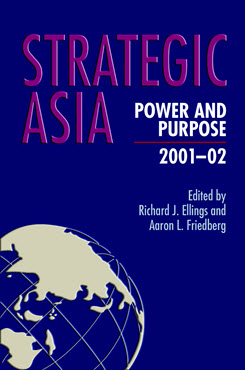Russia (Strategic Asia 2001-02)
The purpose of this chapter is to explain the main lines of Russian policy in Asia, to anticipate its course over the next five years, and to extrapolate intermittently to highlight trends that promise to endure beyond that period.
Most Russians hope that the transformations underway in their country will create a prosperous market economy and democratic polity and that Russia becomes a full-fledged member of “the West.” Indeed, in their minds, Russia is a European society, no matter what others may think or say. Yet Russia’s history and geography also tie it inextricably to Asia.
Russia’s current boundaries were established by an imperial expansion south and east across Asia. Over 60 percent of its territory lies in Asia, and it borders five Asian states: China, Japan, Kazakhstan, Mongolia, and North Korea. And those responsible for Russia’s foreign and defense policy regard Central Asia as falling within Russia’s strategic, as opposed to juridical, boundaries. However much Russians see themselves as being outside of Asia, through the centuries their conception of the present and the future has, nonetheless, developed from an interaction with Asia—one marked by cooperation and conflict, victory and defeat, acceptance and rejection.
My purpose in what follows is to explain the main lines of Russian policy in Asia, to anticipate its course over the next five years, and to extrapolate intermittently to highlight trends that promise to endure beyond that period. To that end, I consider Russia’s interests in Asia, the resources it has available to pursue them, the external circumstances it will face, and how means and context will shape what it does in Asia’s major regions. Since I am interested in strategic choices and not tactical moves, the quotidian details of policy will not loom large in my analysis. Nor do I dwell on how Russian policy is formulated or the ways in which it is influenced by public opinion or self-promoting bureaucracies—not because these issues are unimportant, but because they are incidental to my goal.
This perspective contrasts with the propensity to see politics as an extension of personality and to focus on the short term. U.S. thinking on, and policy toward, Russia is marked by this inclination to exalt one-to-one relationships, trust, and communication. The result is that diplomacy and strategy take on the traits of therapy, individual leaders are invested with overweening significance, and larger patterns are missed, as the texture of trees becomes more important than the forest’s contours. Policy becomes the process of dealing with particular leaders, who become the repositories of our hopes, or the targets of our inevitable disillusionment, and lurching and veering is the unavoidable consequence. For constancy’s sake, and given my particular objectives, it is better to understand what Russia is doing and to foresee what it is apt to do by focusing on “structural conditions.”
By this I mean the strategic, economic, and demographic forces that affect a state’s power and that of its likely adversaries and allies and that are visible now and that we can expect, with reasonable confidence, to provide the setting for leaders’ decisions for several years. I rely on structural conditions to answer four questions about Russia’s place in Asia. First, what is the quantity and quality of resources that Russia can mobilize in pursuit of its goals in Asia? Second, what are these goals, and how do history, geographical circumstances, and the power and policies of other states shape them? Third, what are the major objectives, constraints, and opportunities that will guide Russia’s relations with Central Asia, the South Caucasus (Armenia, Georgia, and Azerbaijan), Afghanistan, Turkey, and Iran, South and East Asia (India, China, Japan, North and South Korea, and the United States)? Fourth, how will Russia’s capabilities and constraints in Asia affect the United States and what policies should the United States adopt in response? Throughout, I try to show that Asia has a strategic unity such that developments in one region course through the continent and affect others.
Strategic Asia
The Strategic Asia annual edited volume incorporates assessments of economic, political, and military trends and focuses on the strategies that drive policy in the region. Learn more about Strategic Asia.


